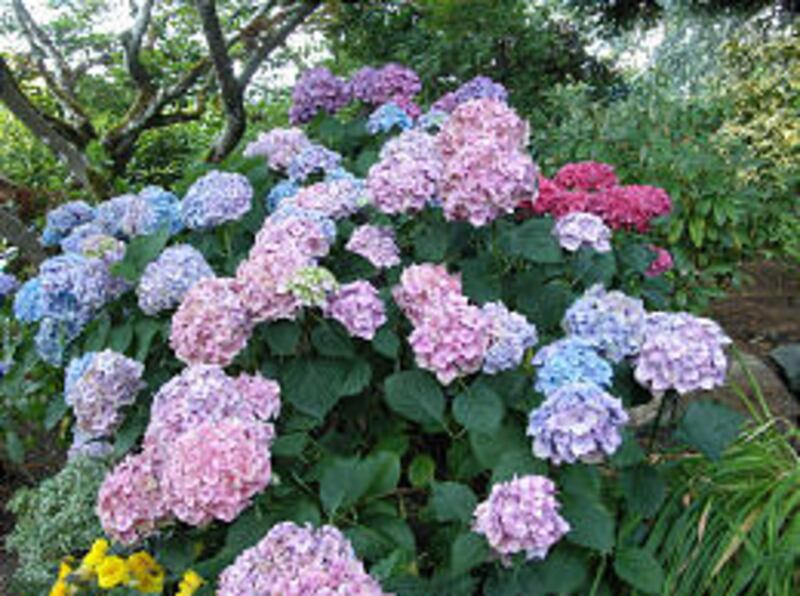Recently, I took a group of gardeners to the Pacific Northwest. In the gardens we visited, one flowering shrub — the hydrangea — stood out from the rest. Everywhere you looked, beautiful white, pink, blue and lavender flowers graced the landscape.
If you are not familiar with these plants, now is a good time to get acquainted. But I must add a disclaimer: Not all hydrangea varieties are hardy in our area, and they all prefer well-drained soil with a near-neutral pH. If your soil is highly alkaline or salty, or if you have consistent severe wind, these plants are not suitable for your landscape.
Let's start with the white or cream colored hydrangea varieties. PeeGee — or Hydrangea paniculata "Grandiflora" — gets its name from the initials of its species and variety. This vigorous variety is also known as panicle hydrangea and is the hardiest of the plants.
The large, showy, creamy white conical-shaped blossom clusters appear in August and September. After a few weeks, they fade to an attractive bronze-pink that holds well into the fall. The shrub grows 8-10 feet tall with a similar spread. Plant them in moist, well-drained soil in sun to partial shade. Because PeeGee hydrangeas are so hardy, there usually isn't much dieback.
"Tardiva" is closely related to PeeGee but is hardy only to Zone 4. It blooms slightly later and features smaller flowers. The rounded shrub grows 6-8 feet tall and 8-10 feet wide, so allow plenty of space. Plant in partial shade to full sun in well-drained loamy soil. It tolerates a wide soil pH range.
"Unique" is another close relative of the PeeGee and "Tardiva." It has large white flowers and forms an upright, mounded shrub that can grow 8 feet tall and 10 feet wide. Plant it in either light shade or full sun. PeeGee, "Tardiva" and "Unique's" flowers bloom on new wood, so they should be pruned in early spring.
"Pink Diamond" grows 3-4 feet wide and tall with a neat, mounding habit. It blooms on new growth in July and August with large pink flowers. Plant in moist, well-drained soil and full sun to light shade. The plant is hardy to Zone 4.
Hydrangea arborescens "Annabelle" is also known as a Snowball hydrangea (or smooth hydrangea). It produces huge, symmetrical blooms up to 8 inches in diameter in June and July. The plants are hardy to Zone 3, and it can grow 4-5 feet tall and 3-5 feet wide.
Select rich, well-drained soil that stays consistently moist. It tolerates slightly alkaline soil pH and grows best in partial shade. Annabelle blooms on new wood, so cut it back to a foot or two above ground each spring when the new buds emerge on the lower stems.
Oak Leaf — Hydrangea quercifolia — prefers a cool, moist environment. It is hardy to Zone 5, but the plant seems to thrive better in a sheltered location with good winter protection. In our climate it grows 3-4 feet tall and spreads to a similar width.
Oak Leaf seems to be one of the easiest varieties to grow here. Plant in sun to light shade in good soil. The plants have large, handsome oak-shaped leaves and cream-colored panicle blooms. As an added bonus, the leaves turn red in the fall.
Climbing hydrangea — Hydrangea anomala petiolaris — is a plant for patient, optimistic gardeners. They are slow to start, sometimes taking several years to get going. Once the roots are well-established, they are vigorous, climbing stucco, brick, fences or trees. They feature glossy, bright green leaves and creamy white flowers in June and July.
Plant them in rich, well-drained soil in partial shade. They will eventually grow 20-30 feet long and do best when the root system is well-mulched during the winter. They are a Zone 5 plant. They require little or no pruning, but if shoots grow out of bounds, trim them back in the summer.
The colored hydrangea varieties are trickier to grow, but they are very striking. Plant enthusiasts may consider some of these. Hydrangea macrophylla, sometimes known as house or florist hydrangea, features large pink or blue flower clusters. Choose selected varieties that tolerate cold and alkaline soils.
"Endless Summer" was discovered in Minnesota, so it is cold-hardy. It blooms on both old and new wood, and the flowers are pink in alkaline soils and blue in acidic soils. The plant grows 3-5 feet high and wide and blooms in late July. Some winter protection is a good idea. Light pruning in early spring to shape the plant may remove some buds, but the plant will bloom on new wood.
"Nikko Blue" is one of the showiest hydrangeas. It is rated for Zone 5 but does best with some winter protection. It needs acidic soil with a pH below 6.0 to bear the brilliant blue flowers, so content yourself with the pink blooms from plants placed in neutral or alkaline soils. It grows 4-5 feet tall and wide. The blooms appear in July and August and are usually larger than 6 inches across.
"All Summer Beauty" is a close relative of "Nikko Blue" and flowers in July and August. It grows 3-4 feet tall and 3-5 feet wide. It is a Zone 5 plant, like "Nikko Blue," but it is hardier because it blooms on new wood and is easier to overwinter. Plant it in a sheltered location with well-drained soil and full sun to light shade.
Although these plants are not for every Utah landscape, many do well here. Carefully select the variety and match it to your growing area, then be patient. Your reward may be some of the best summer-flowering shrubs you have ever grown.
Larry Sagers is the horticulture specialist for Utah State University Extension at Thanksgiving Point.



